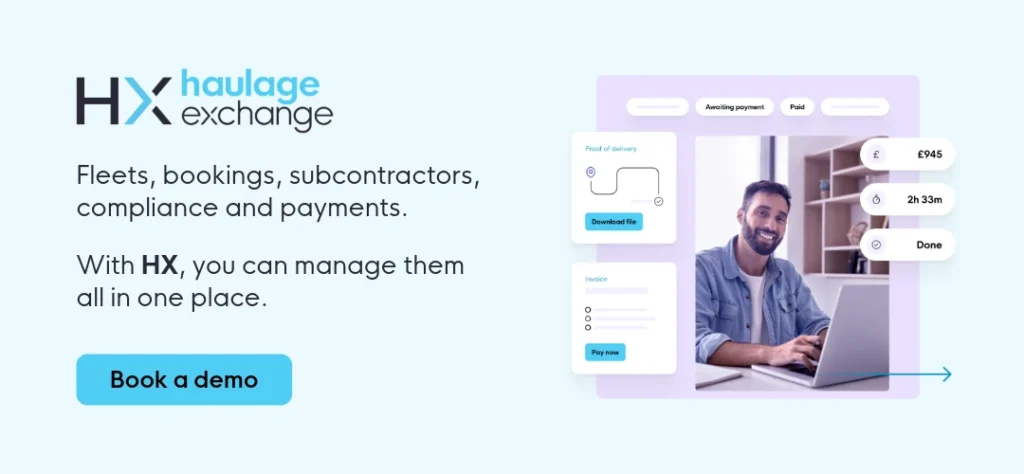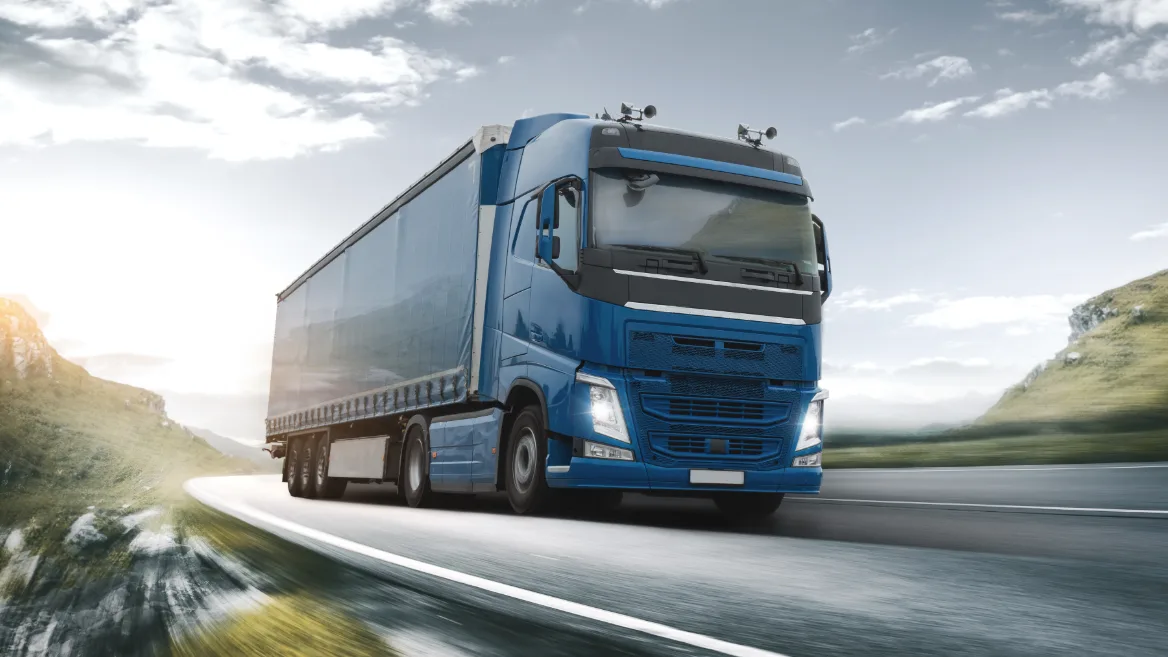A waybill is a document that travels with goods during transport and outlines the important details of the shipment. It’s used by carriers, recipients, and customs officials to track, move, and confirm delivery of goods.
In this guide, we’ll break down the full waybill meaning, how waybills compare to similar documents, and what you need to know if you’re moving freight across the UK or internationally.
What we’ll cover
Fleets, bookings, subcontractors, compliance & payments.
With HX, you can manage them all in one place.
Why waybills are necessary in logistics
A waybill acts as the backbone of many transport operations. It provides a clear and written summary of what’s being moved, who it’s for, and how it’s getting there.
Because the waybill travels with the goods, it’s available whenever there’s a handover, checkpoint, or delivery. It’s often needed for smooth customs clearance, especially when moving goods between countries.
It also supports more accurate and transparent communication between parties, particularly freight forwarders, carriers, and recipients.
In short, a waybill helps prevent confusion, delays, and disputes during the shipping process.
Main components of a waybill
A standard waybill includes a few important sections. These help keep everyone in the loop from the moment goods leave the warehouse until they’re delivered.
You’ll typically find:
- The names and contact details of the sender and receiver
- A full description of the goods (weight, quantity, packaging)
- Pickup and delivery addresses
- Handling instructions or special notes
- The carrier’s name and vehicle or flight details
- The waybill number, which is used to track the shipment
All these fields work together to support the core waybill meaning. In other words: a detailed, transport-ready summary of your shipment that travels with the goods.
If you’re still wondering what is a waybill number, it’s simply the unique code that identifies your shipment. This number is important for tracking in real time and is often entered into carrier systems or freight exchange platforms to keep tabs on the shipment’s status.
Types of waybills
There’s more than one type of waybill, and each is tailored to the mode of transport being used. Below are the most common types you’ll come across.
Road waybill
Also called a CMR (after the French term for the convention that regulates it), the road waybill is used when goods travel by lorry across borders.
It contains standardised sections for all the necessary info required under European law.
Rail waybills
These are used when goods are transported by train. A rail waybill will often include extra details about the rail route, wagons, and handling instructions.
Air waybill
Used for air freight, the air waybill (AWB) is a non-negotiable document that outlines the terms of the air cargo contract.
It’s standardised by IATA and is one of the most widely recognised waybill types.
Sea waybill
The sea waybill is used for ocean freight, and unlike a bill of lading, it doesn’t serve as proof of ownership.
This speeds up delivery since the recipient doesn’t need to present the original document to collect their cargo.
House waybills
These are created by freight forwarders to cover individual shipments within a larger load. They’re often used when several clients’ goods are combined into one container.
Master waybills
A master waybill is issued by the main carrier (like a shipping line or airline) and covers all goods in a consolidated shipment. It links directly to the house waybills inside.
Multimodal waybills
If your goods are travelling by more than one method (say, road and sea), you’ll use a multimodal transport waybill. This provides one document to cover the entire journey, simplifying handovers and recordkeeping.

Waybill vs bill of lading
It’s easy to confuse a waybill with a bill of lading (BOL), but there are some clear differences. The biggest one? A waybill is not a document of title, so it can’t be used to claim ownership of the goods.
Here’s a breakdown to make it clear:
| Feature | Waybill | Bill of lading |
|---|---|---|
| Document of title | No | Yes |
| Can transfer ownership | No | Yes |
| Used for customs | Yes | Yes |
| Slows down delivery | No – no need to present original | Yes – often must present original |
| Issued by | Carrier or forwarder | Carrier |
| Tracking number | Has a waybill number | Has a BOL number |
A waybill is simpler and quicker to use in many cases, especially when there’s no need to transfer ownership during transit. If you’re working with a freight forwarder, they’ll advise you on when a BOL is required instead.
Wondering how different transport roles work together? Make sure to investigate the difference between freight brokers and freight forwarders.
Functions and legal importance of waybills
Although a waybill doesn’t transfer ownership, it still plays several important roles. Here’s what it does:
Contract of carriage
A signed waybill acts as evidence of the agreement between the sender and the carrier. It outlines what’s being shipped and under what terms.
Receipt of goods
The waybill also serves as proof that the carrier has taken possession of the goods. This can be helpful when working out disputes or confirming delivery status.
Tracking and dispute handling
The waybill number allows everyone involved to track the shipment from start to finish. If anything goes missing or arrives damaged, the waybill is often the first thing reviewed.
How to complete a waybill
If you understand the waybill meaning, you’ll know it’s more than just admin: it’s what keeps your shipment moving without delays, confusion, or disputes.
Here’s a practical guide to getting it right.
What to include on your waybill
Make sure these sections are completed clearly and accurately:
- Sender and receiver details: Add full names, addresses, phone numbers, and (if applicable) company names. These must be correct, since even a small mistake can cause delivery issues.
- Description of the goods: List the quantity, weight, dimensions, and type of goods being shipped. Mention how the items are packed (e.g. boxes, pallets, crates).
- Waybill number: As you now know, this is the tracking reference for the shipment. If your system doesn’t generate one, ask your carrier or freight platform for guidance.
- Pickup and delivery details: Enter the full collection and delivery addresses, including postcodes. Add any delivery windows or timing requirements if needed.
- Carrier and transport info: Include the name of the carrier, vehicle registration or flight number, and the planned route if known. This helps link the waybill to the right journey.
- Special instructions: If the shipment needs to be handled in a particular way (e.g. fragile, chilled, or hazardous goods), make a clear note here. It’s better to over-communicate than assume someone will know.
- Signature or confirmation section: Many waybills include a space for the recipient to confirm delivery. This may be digital (for e-waybills) or physical, depending on how your carrier operates.
Who fills in what?
The sender usually completes the first part of the waybill, especially anything related to the goods themselves. It’s their responsibility to give an accurate and full description.
The carrier or freight forwarder may complete transport-specific fields, like routing or reference numbers. In some cases, they’ll double-check the document before pickup to make sure nothing’s missing.
Before the shipment leaves, make sure both parties have a copy (physical or digital). If you’re using a freight exchange or logistics platform, the document may be shared and stored automatically.
Common errors and how to avoid them
Here are some of the most common mistakes seen on waybills. We’ll also explain how to avoid them:
- Missing or incorrect waybill number: Without a valid number, tracking becomes a nightmare. Always double-check the format before issuing the document.
- Wrong recipient details: A simple typo can send your shipment to the wrong location. Always confirm names and addresses with the receiver before dispatch.
- Vague product descriptions: Not stating exactly what’s in the shipment can lead to customs clearance issues. Be clear about what’s inside, how it’s packed, and what it’s used for.
- Skipping special instructions: If the goods are fragile, temperature-sensitive, or hazardous, this must be noted on the waybill. Don’t rely on word-of-mouth.
- Not updating information after changes: If anything changes mid-shipment (like the delivery address), update the waybill and let everyone know. This helps avoid disputes down the line.
Waybill examples and templates
There’s no one-size-fits-all template, but most waybills follow the same structure. If you’re creating one from scratch or filling in a digital version, look for:
- Sender and receiver fields
- Description of goods
- Carrier information
- Tracking number (your waybill number)
- Handling instructions
- Delivery confirmation section
Most carriers and freight exchange platforms provide templates you can download or fill in online. Some also offer e-waybills that update in real-time and reduce paperwork.
Frequently asked questions
Can a waybill be used as proof of ownership?
No, unlike a bill of lading, a waybill doesn’t transfer title of the goods. It’s used for tracking, delivery, and as a receipt, but not for claiming ownership.
What’s the difference between a waybill and a bill of lading?
The main difference is that a bill of lading acts as a title document, while a waybill does not. A waybill is faster to process because it doesn’t need to be presented to collect goods.
Do I need a waybill for customs clearance?
Yes, especially for international shipments. It helps customs identify what’s being transported, how, and who’s involved, which links directly to import tax and customs duties.
What should I do if my waybill contains errors?
Fix the errors before the shipment is picked up if possible. If it’s already en-route, notify your carrier or freight forwarder straight away so they can update the info.
Are electronic waybills valid?
Yes, e-waybills are widely accepted and often preferred. They’re easier to update and track, and many platforms now offer digital documentation as standard.




